10.5 Part Writing, Seventh Chords: Tutorial
Part Writing with 7th Chords
To review the types of seventh chords found in tonal music, see Chapter 5.2.
Seventh chords can be separated into dominant seventh chords, leading tone seventh chords, and non-dominant seventh chords. Each group will be discussed separately.
The V7 chord
The V7 chord, also called the dominant seventh chord, is the most frequently used and strongest seventh chord in music. The dominant seventh chord is a frequent substitute for V. Due to its strength, it is used most often in root position at cadences, and most often found in inversions within a phrase. It is not typically used for a half cadence due to its strength.
V7 tendency tones
The V7 chord is strong because it has two tendency tones: the leading tone and the chordal seventh. The leading tone most often resolves up to tonic and the chordal seventh always resolves down by step. The added chordal seventh also creates a tritone interval between scale degrees 4 and 7, which increases its dissonance and its need to move to tonic to resolve.
Part Writing the V7 in Root Position
There are three ways to part write a V7-I progression when V7 is in root position. The first option is to have a complete V7 chord move to an incomplete I chord, where the I chord omits the 5th of the chord. The omission of the 5th and triple root is necessary to avoid doubling the 3rd of the chord or to avoid contrary or parallel 5ths. Memorize the scale degree movements between V7 and I.
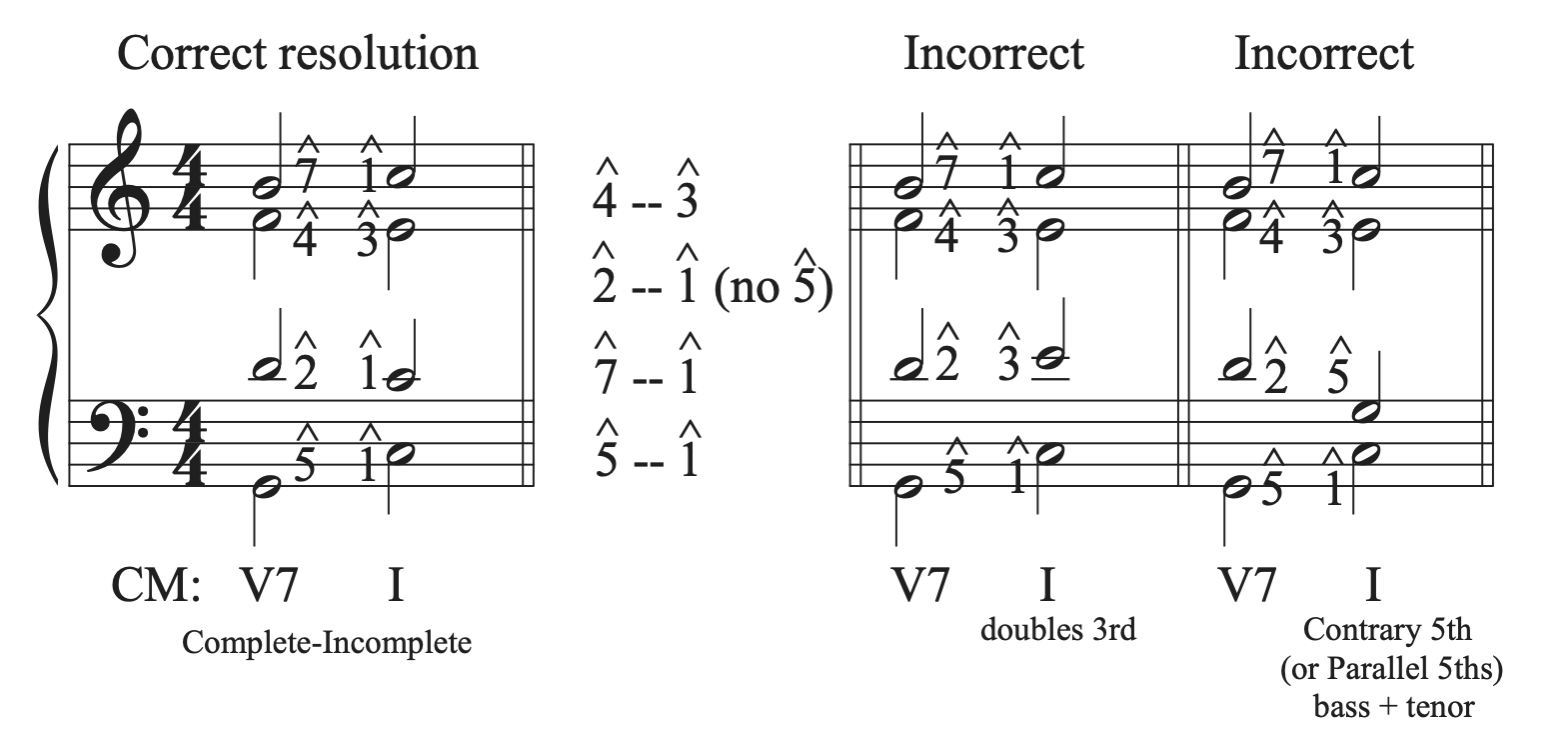
The second option to have an incomplete V7 chord move to a complete I chord. An incomplete V7 chord will omit the 5th of the chord. Memorize the scale degree movements between V7 and I.
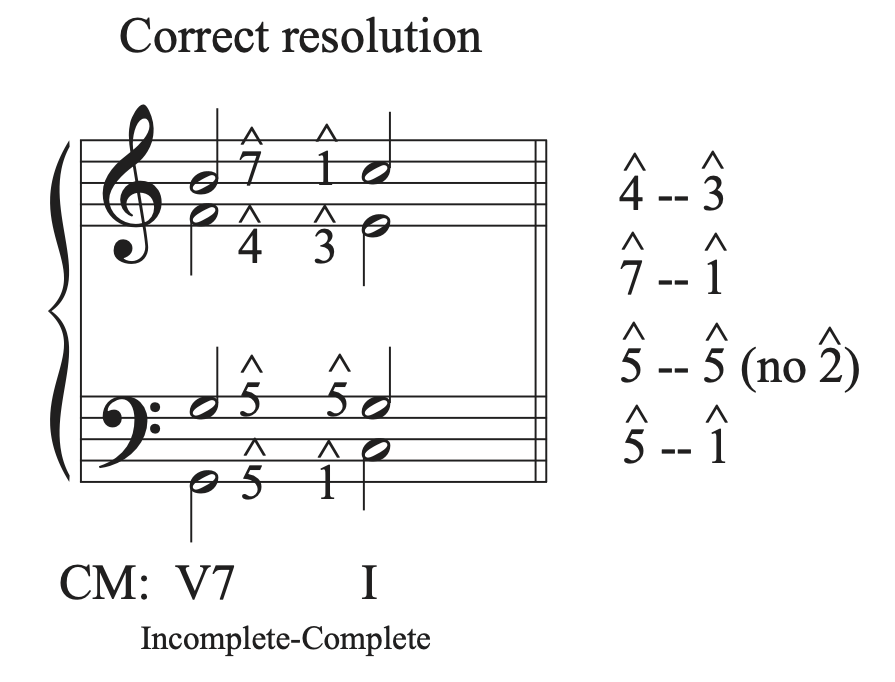
The third option is to use a complete V7 and a complete I chord. In this option, it is impossible to resolve the leading tone to scale degree 1. It must move down to scale degree 5, and must be an inner voice. Memorize the scale degree movements between V7 and I.
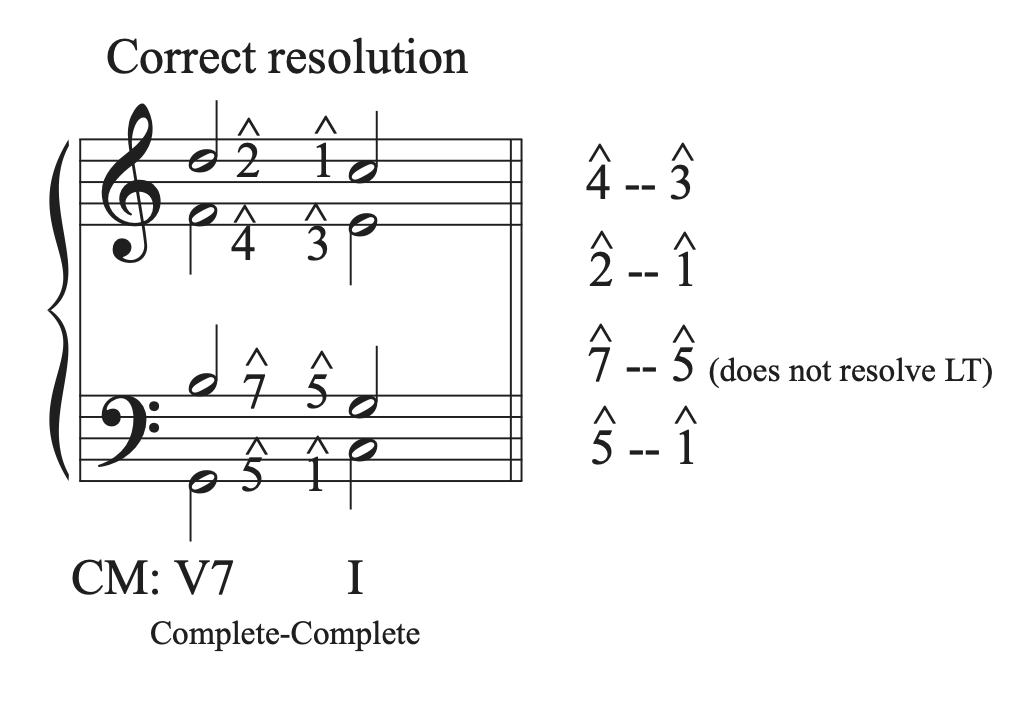
Other resolutions of V7 in root position
In a V7-vi progression, the bass moves from scale degree 5 to 6. The leading tone will resolve to scale degree 1, or can go to 6 if it’s in an inner voice. The other voices will move down by step.
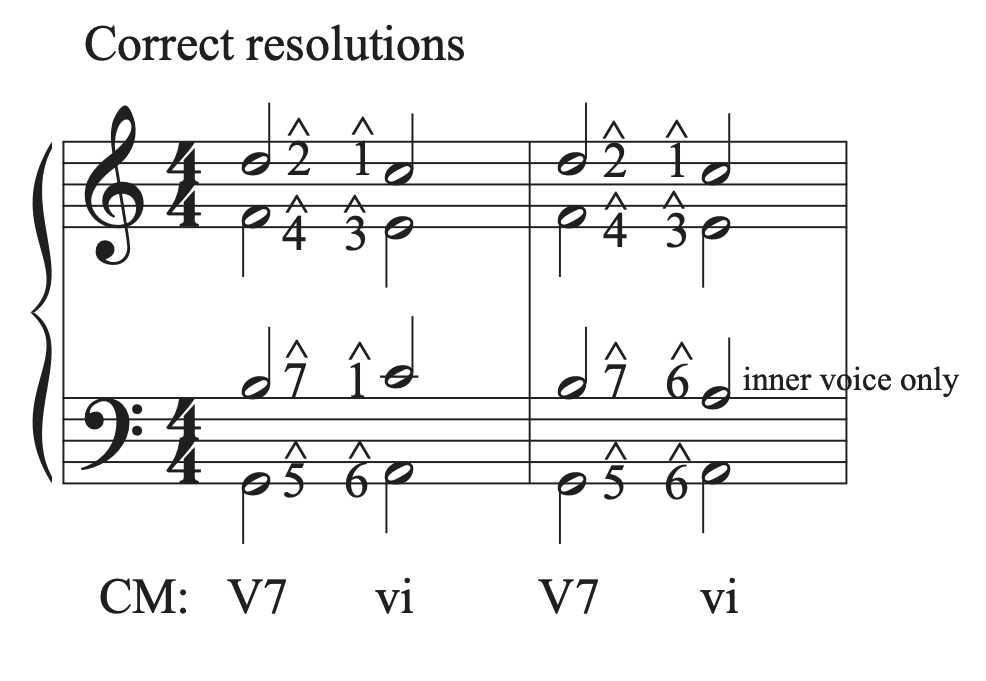
Part Writing V7 in Inversions
Part writing for V7 chord in inversion is less complicated than the root position V7. All chords will be complete and each V7 chord will resolve in the following way:
Scale degrees move from:
- 5-5
- 7-1
- 2-1
- 4-3
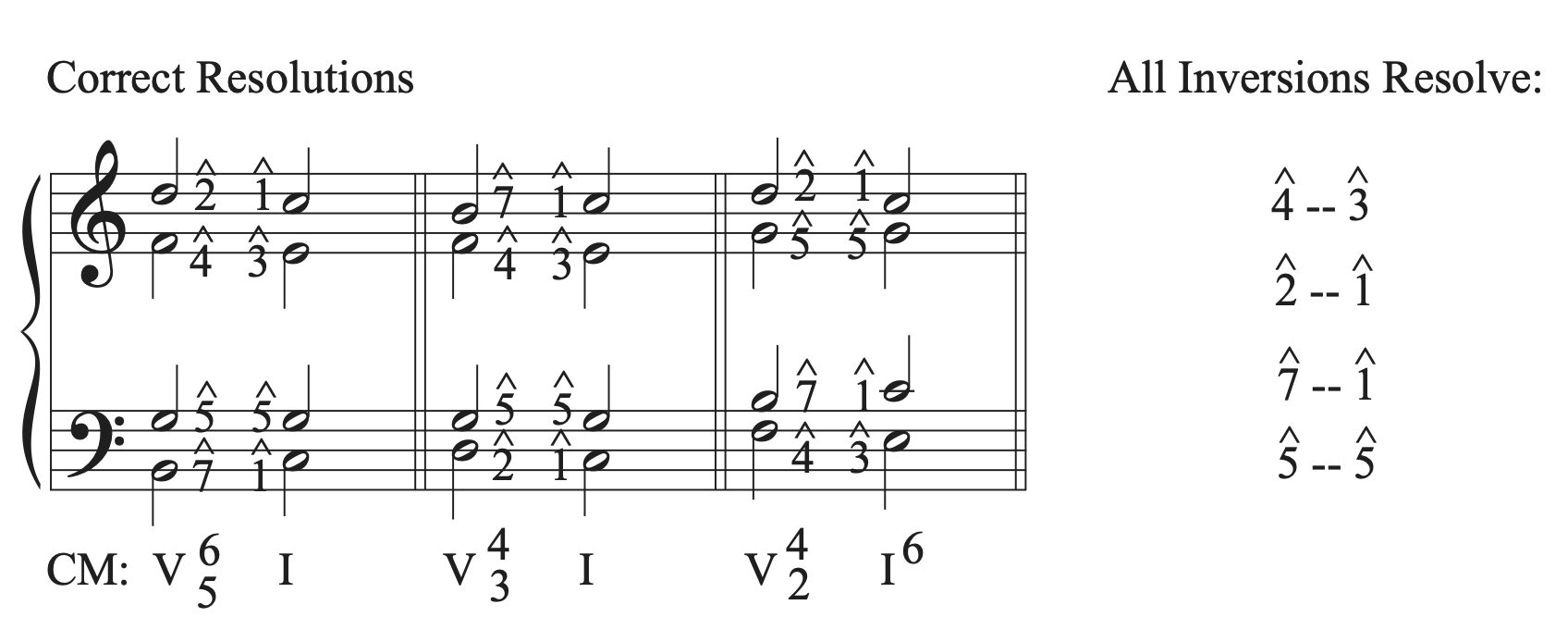
Leading tone 7th chords
The viiø7 and vii˚7 chords are leading tone seventh chords. Part writing these chords can be challenging due to the possible parallel and unequal 5ths that can develop due to the tritones in the chords. In general, both chords resolve using the same scale degree motions to a tonic chord:
- 7-1
- 2-1 or 2-3 to avoid errors
- 4-3
- 6-5
Leading tone seventh chords can also move to V7 and its inversions before resolving to tonic.
viiø7
The viiø7 chord is used less often than V, V7, and vii˚ chords. It normally resolves to a I chord, but can also move to V6/5 first. Both chords will be complete. When part writing, scale degrees move from:
- 7-1 (or stay on 7 if moving to V6/5)
- 2-1 or 2-3 (or stay on 2 if moving to V6/5)
- 4-3
- 6-5
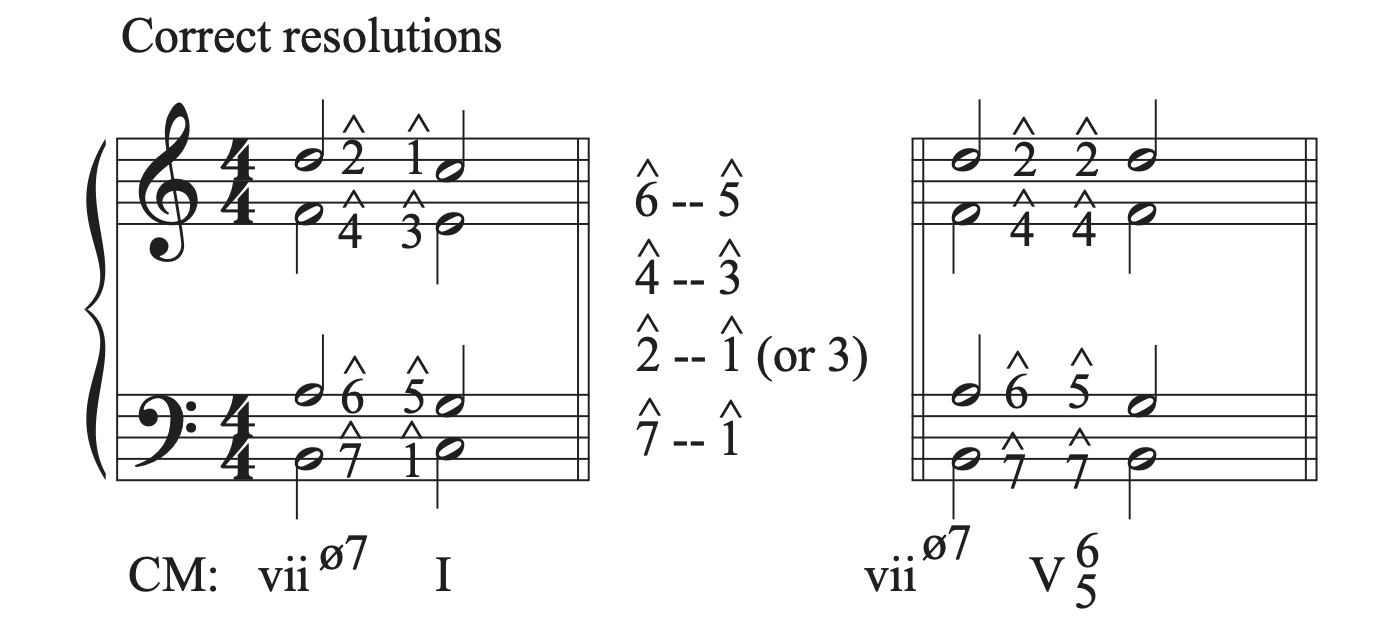
Parallel 5ths are a common problem in part writing the viiø7 chord. Parallels can be avoided by doubling the 3rd of the I chord or re-voicing the chord so that parallel 5ths are replaced by parallel 4ths.
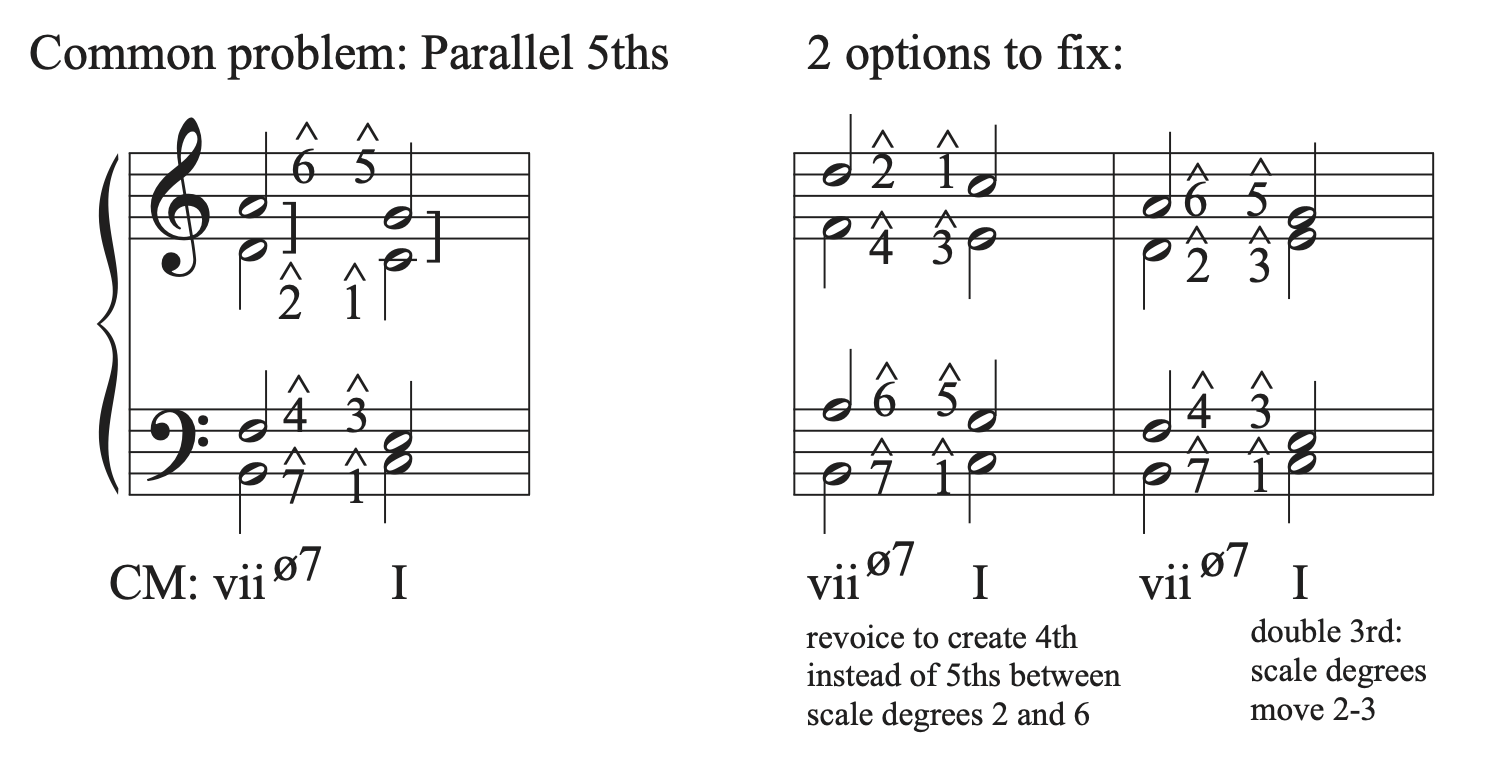
vii˚7
The vii˚7 chord contains two tritone intervals that need to be resolved. This creates a highly dissonant chord with tendency tones that create forward motion. Scale degrees generally move:
- 7-1 (or stay on 7 if moving to V6/5)
- 2-1 or 2-3 (or stay on 2 if moving to V6/5)
- 4-3
- 6-5
The root position vii˚7 chord resolves to I or V6/5.
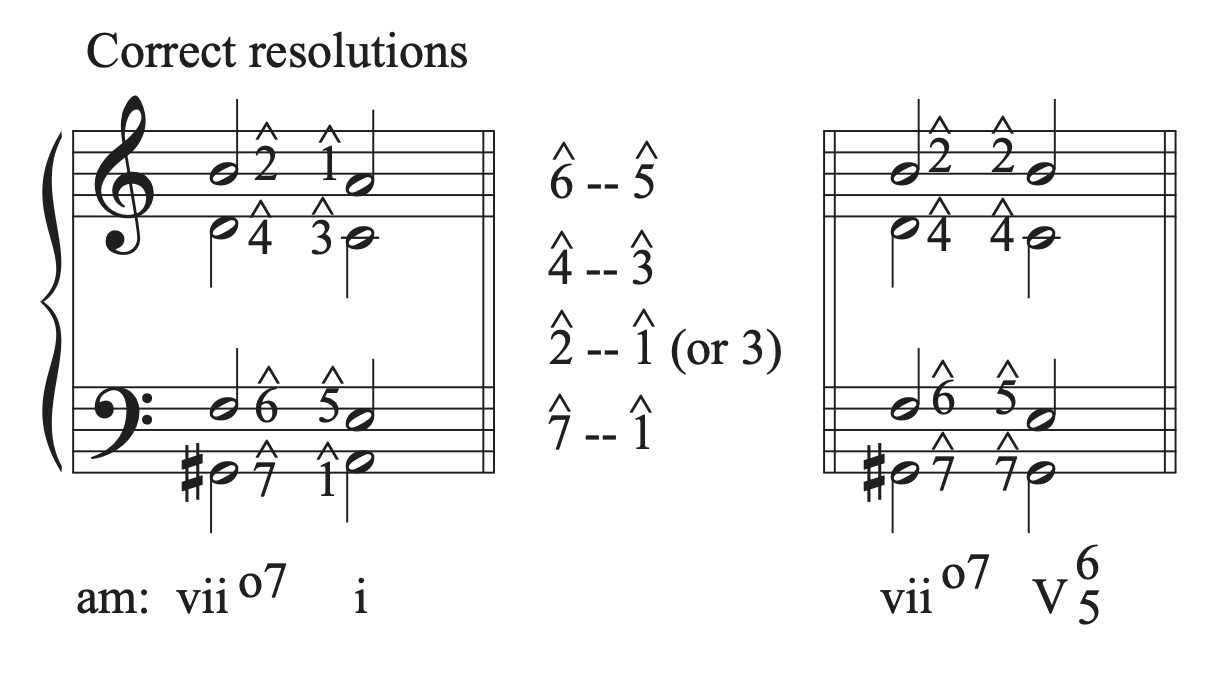
In first and second inversion, it usually resolves to I6 to avoid part writing errors.
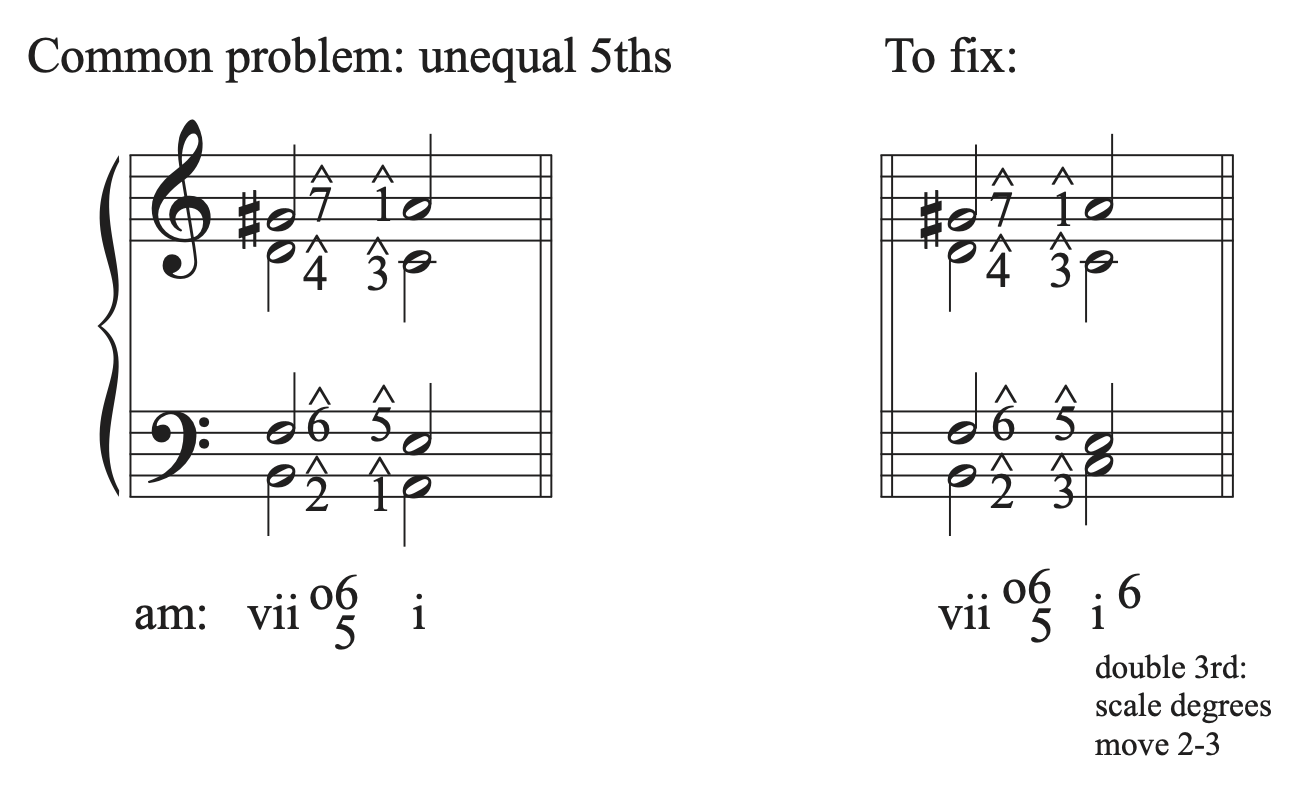
In third inversion, it is usually followed by V7 or either a cadential 6/4 or passing 6/4 chord. It is used less commonly in 3rd inversion.
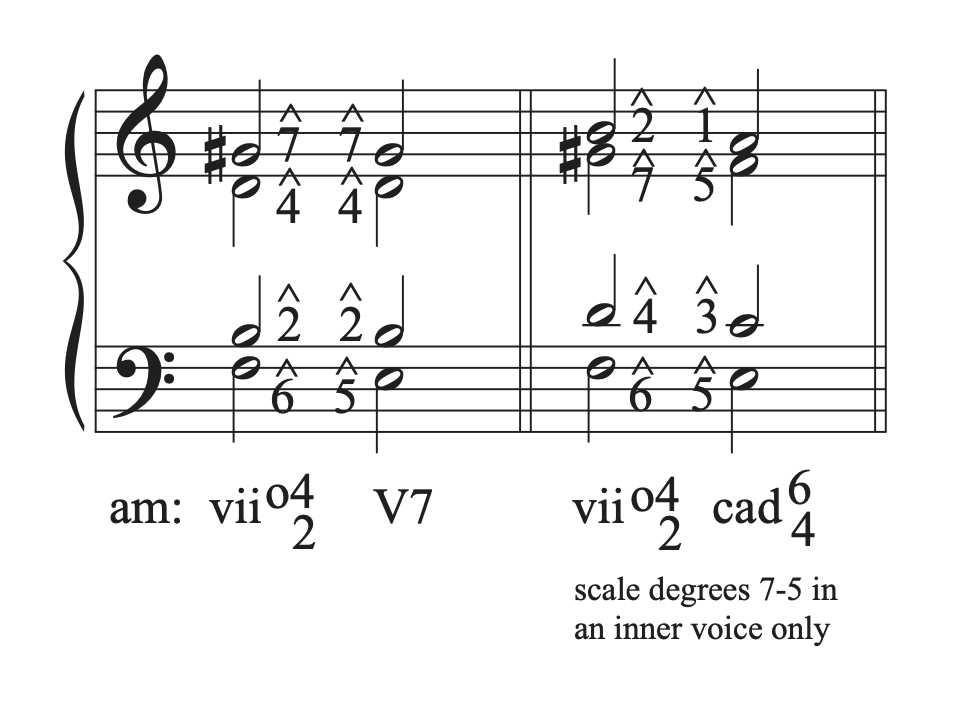
Non-dominant seventh chords
Non dominant seventh chords are any seventh chord build on a scale degree other than 5 or 7. In a major key we use: ii7, iii7, IV∆7, and vi7. In a minor key we use: i7, iiø7, III∆7, iv7, and VI∆7.
Part writing for non-dominant seventh chords is not as specific as for dominant and leading tone seventh chords. In general:
- Resolve the chordal 7th down by step
- Resolve tendency tones
- Most chords are complete. An incomplete chord will omit the 5th.
- All non-dominant seventh chords function the same as their triad counterparts, but I∆7 should not be substituted for I when I is used in a structural context, like at a cadence.
Non-dominant seventh chords: specific chord details
ii7
The ii7 chord is the most common non-dominant seventh chord. It typically moves to a dominant function chord. Root position ii7 is often used near the end of a phrase, leading to V. First inversion ii6/5 often substitutes for ii6 in a progression, leading to V near the end of a phrase. Third inversion ii4/2 is most often used at the beginning of a phrase leading to V to expand tonic. The second inversion ii4/3 chord is not commonly used, but when used it substitutes for a predominant at the end of a phrase.
IV7
The IV7 chord typically moves to a dominant function chord, often passing through some form of the ii chord. Resolution to ii7 is especially easy because only the chordal 7th moves. When part writing iv7-V, parallel fifths can occur, and can be avoided by voicing the chord differently or by first moving to a cad 6/4 chord. The IV7 chord is most often found in root position in a progression.
VI7
The VI7 chord, like the vi chord, is most often used to expand tonic, moving to a predominant, before moving towards V. This chord serves as a passing chord between two dominant function chords, and moves smoothly to vii˚. The VI7 chord is not used in deceptive cadences.
I7
Adding a 7th to the tonic triad weakens its tonal stability, creating an active chord that needs to resolve. It often moves to IV, though sometimes moves to vi or ii. The resolution chord must contain scale degree 6 so that the chordal 7th (scale degree 7) can move down by step to resolve.
III7
The III7 chord is the least frequently used seventh chord, and most often occurs in sequences. It usually moves to VI or VI7 and can also be followed by IV.
Part writing non-dominant seventh chords:
- Chordal 7th always resolves down by step
- Move all other voices in a way that avoids errors (no strict scale degree motion like the dominant function 7th chords)
Approaching the resolving the chordal seventh of any seventh chord
Remember to check the approach and resolution of each seventh chord. The chordal seventh must be approached through common tone motion (like a suspension) or by step (like a passing tone or neighbor tone). The chordal seventh must resolve down by step in the next chord.
Summary of Part Writing with 7th chords
- The chordal seventh of any 7th chord must resolve down by step.
- The chordal seventh must be approached through common tone motion (like a suspension) or by step (like a passing tone or neighbor tone).
- Dominant 7th chords
- V7 in root position
- Complete V7 to Incomplete I uses scale degrees:
- 5-1
- 7-1
- 2-1
- 4-3
- Incomplete V7 to Complete I uses scale degrees:
- 5-1
- 7-1
- 5-5 (no 2)
- 4-3
- Complete V7 to Complete I
- 5-1
- 7-5 (inner voice only)
- 2-1
- 4-3
- V7 in inversions resolving to I uses scale degrees:
- 5-5
- 7-1
- 2-1
- 4-3
- V7-vi
- Root motion 5-6
- 7-1 (or 7-6 if in an inner voice only)
- Other voices move down by step
- Complete V7 to Incomplete I uses scale degrees:
- V7 in root position
- Leading tone seventh chords use scale degrees:
- 7-1
- 2-1 or 2-3 to avoid errors
- 4-3
- 6-5
- They can also easily move to V7 using common tones.
- Always check leading tone seventh chords for errors. Avoid errors by re-voicing chords to replace 5ths with 4ths or by moving from scale degree 2 to 3 to double the 3rd in the tonic chord that follows them.
- Non dominant 7th chords
- The chordal seventh always resolves down by step.
- Move all other voices in a way that avoids errors (no strict scale degree motion like the dominant function 7th chords).
Proceed to the theory exercises for guided examples on part writing with seventh chords.

